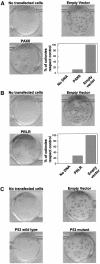Methyl-CpG binding proteins identify novel sites of epigenetic inactivation in human cancer
- PMID: 14633992
- PMCID: PMC291845
- DOI: 10.1093/emboj/cdg604
Methyl-CpG binding proteins identify novel sites of epigenetic inactivation in human cancer
Abstract
Methyl-CpG binding proteins (MBDs) mediate histone deacetylase-dependent transcriptional silencing at methylated CpG islands. Using chromatin immunoprecitation (ChIP) we have found that gene-specific profiles of MBDs exist for hypermethylated promoters of breast cancer cells, whilst a common pattern of histone modifications is shared. This unique distribution of MBDs is also characterized in chromosomes by comparative genomic hybridization of immunoprecipitated DNA and immunolocalization. Most importantly, we demonstrate that MBD association to methylated DNA serves to identify novel targets of epigenetic inactivation in human cancer. We combined the ChIP assay of MBDs with a CpG island microarray (ChIP on chip). The scenario revealed shows that, while many genes are regulated by multiple MBDs, others are associated with a single MBD. These target genes displayed methylation- associated transcriptional silencing in breast cancer cells and primary tumours. The candidates include the homeobox gene PAX6, the prolactin hormone receptor, and dipeptidylpeptidase IV among others. Our results support an essential role for MBDs in gene silencing and, when combined with genomic strategies, their potential to 'catch' new hypermethylated genes in cancer.
Figures







References
-
- Bakker J., Lin,X. and Nelson,W.G. (2002) Methyl-CpG binding domain protein 2 represses transcription from hypermethylated pi-class glutathione S-transferase gene promoters in hepatocellular carcinoma cells. J. Biol. Chem., 277, 22573–22580. - PubMed
-
- Ballestar E. and Wolffe,A.P. (2001) Methyl-CpG-binding proteins. Targeting specific gene repression. Eur. J. Biochem., 268, 1–6. - PubMed
-
- Bird A.P. and Wolffe,A.P. (1999) Methylation-induced repression: belts, braces and chromatin. Cell, 99, 451–454. - PubMed
-
- Cedar H. (1988) DNA methylation and gene activity. Cell, 53, 3–4. - PubMed
-
- Chatah N.E. and Abrams,C.S. (2001) G-protein-coupled receptor activation induces the membrane translocation and activation of phosphatidylinositol-4-phosphate 5-kinase I α by a Rac- and Rho-dependent pathway. J. Biol. Chem., 276, 34059–34065. - PubMed
Publication types
MeSH terms
Substances
LinkOut - more resources
Full Text Sources
Other Literature Sources
Research Materials

